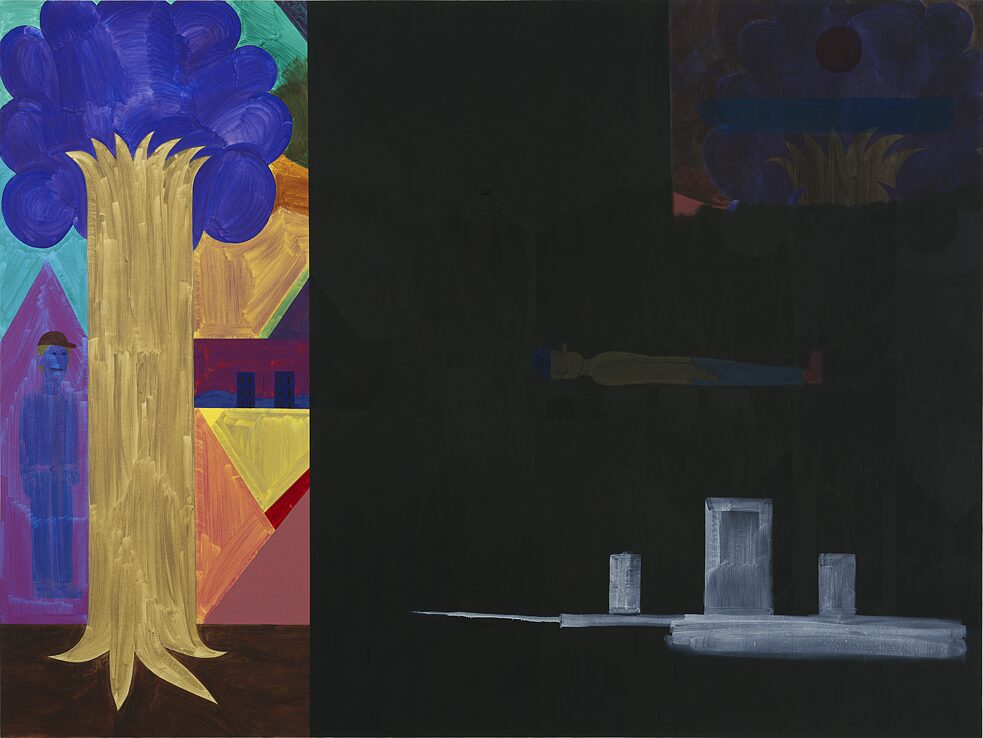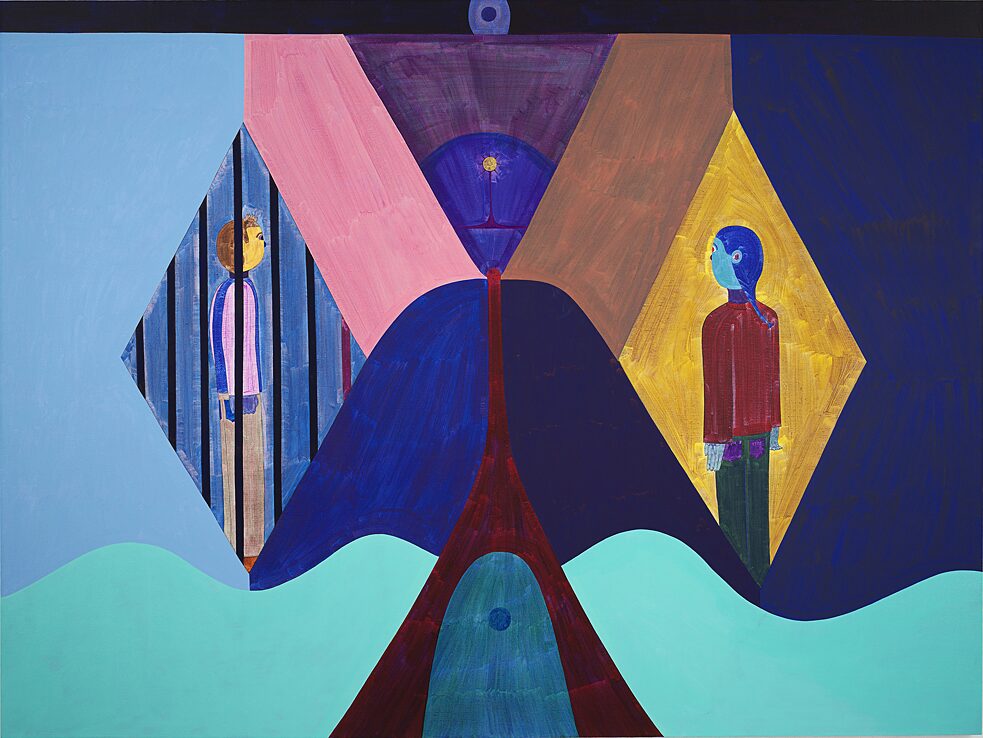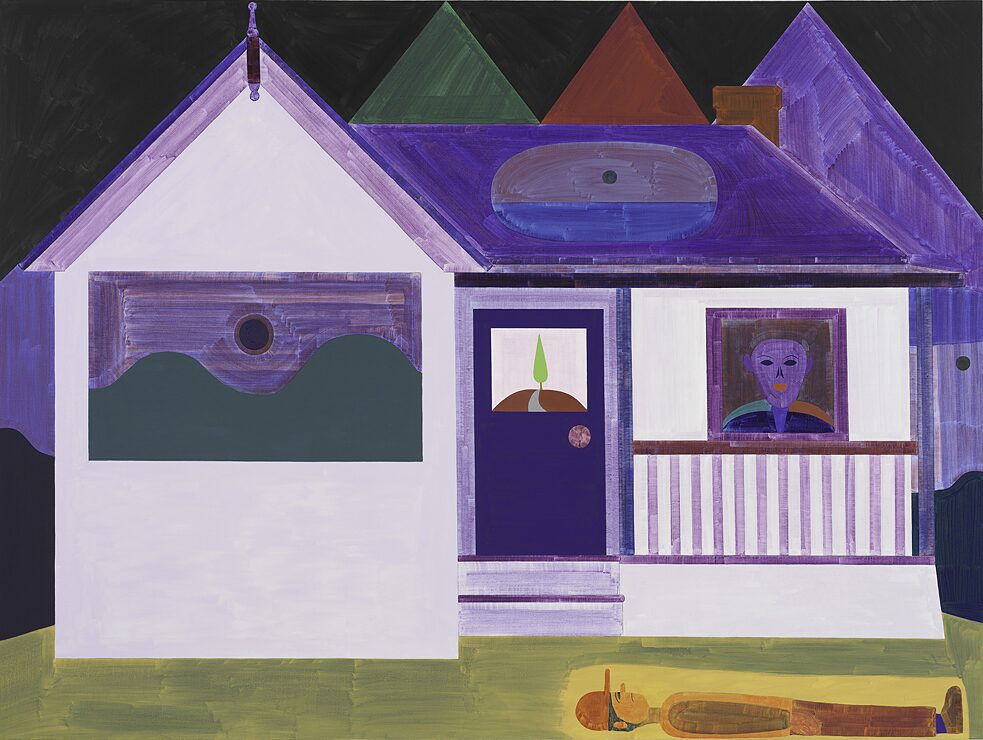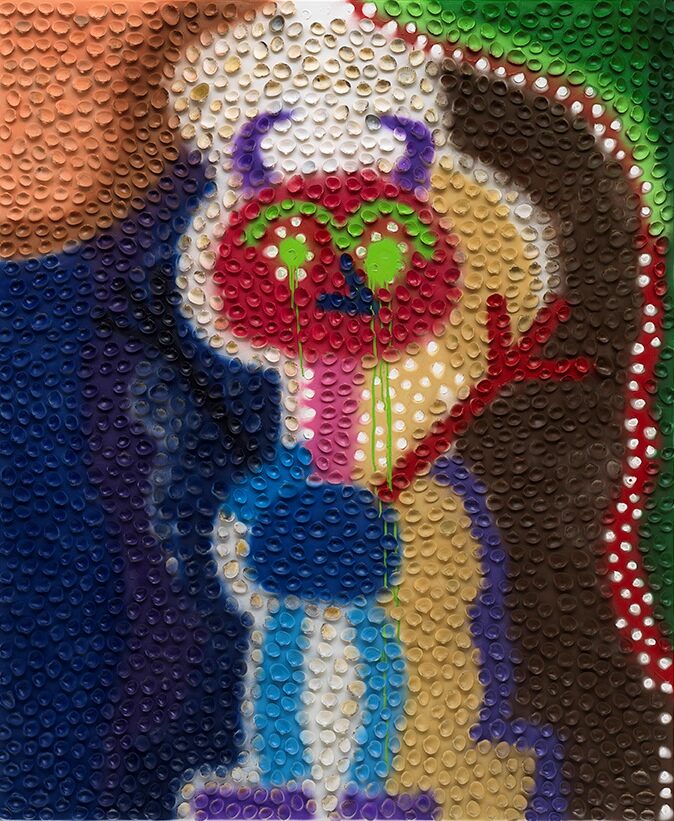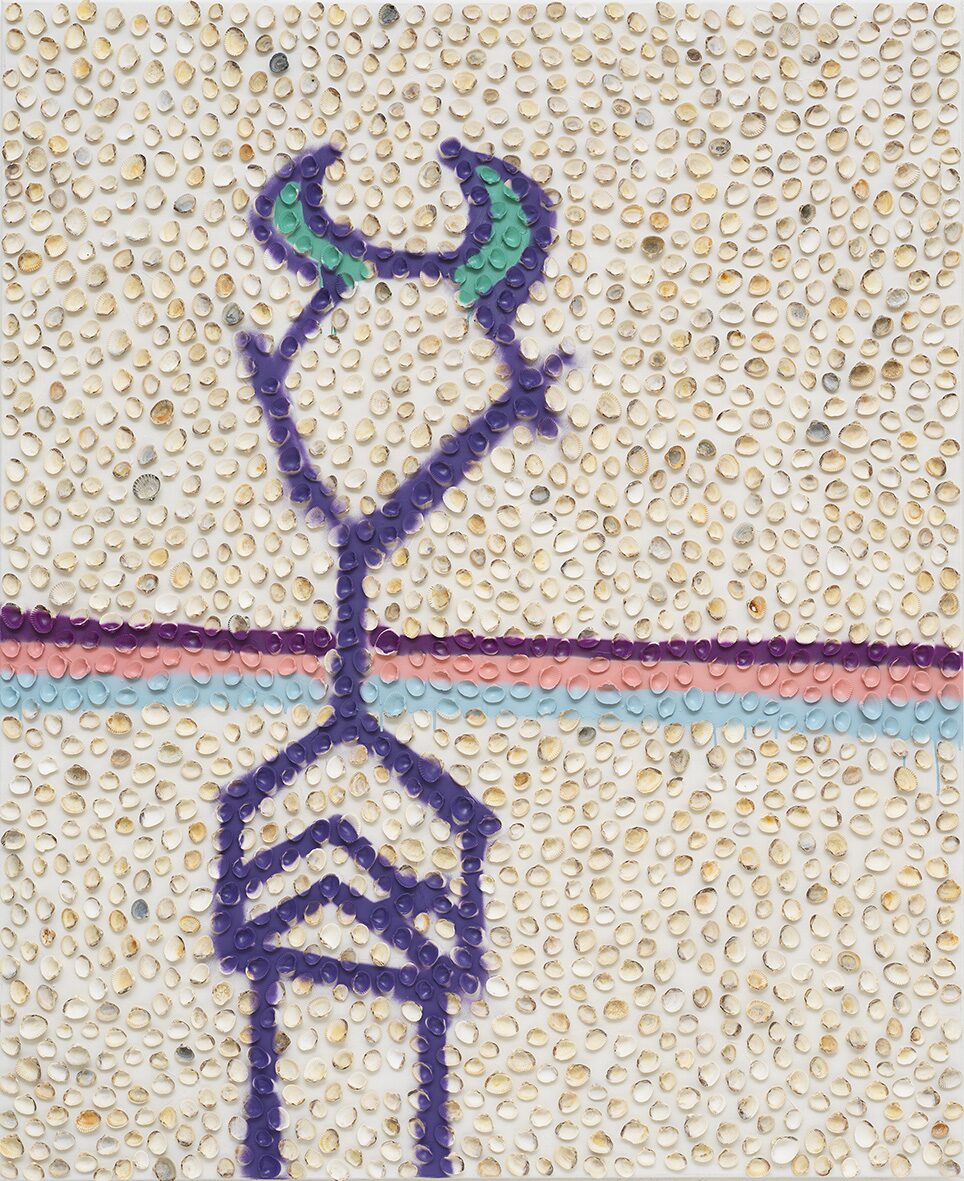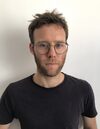Sam Rountree Williams
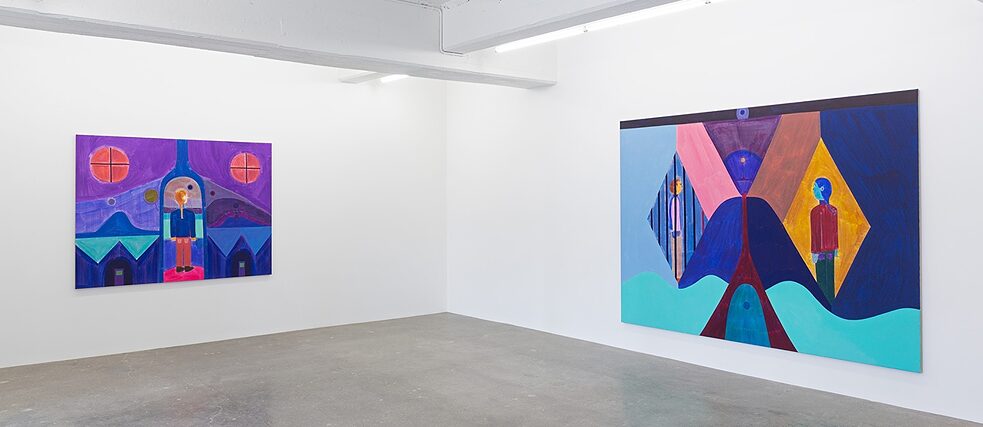
The Goethe-Institut New Zealand and Contemporary HUM present a series of portraits about New Zealand artists who have found a new home - also artistically - in Germany. Scholar Jan Bryant talks to Sam Rountree Williams via videocall.
By Jan Bryant
Sam Rountree Williams has been living away from Aotearoa for a good part of 10 years, studying in Düsseldorf and London, before finally settling in Berlin. We speak by phone in the depths of the Winter Melbourne/Auckland Covid-19 lockdowns. He is on holiday in Paros. It’s summer. It hurts. But picturing him in this terrain of crystal waters and non-verdant coasts, sun and dark histories of war and occupation, plays into the joyful/dark imagination of his paintings, with their scratchy, existential concerns, bathed in slippery colours. His images catch surprisingly.
Soon after finishing at Auckland’s Elam School of Fine Arts (2007), Sam began using tuangi (cockle shells) in his paintings (2008).[1] It is an element that connects his work to both Aotearoa and Europe. I remember seeing them in his apartment-come-studio, at the top of an old, skylighted building downtown. It was a shock to see these new works; to see that Sam was already moving away from the large abstract paintings that he’d only recently developed—muddy, allusive, intriguing, with expanses of colour sitting in fields of ugly browns. These paintings were already difficult and demanded time. I envisaged then that he had reached a platform from which a young painter would begin to dig in, refine, expand. And then, with abandonment, Sam suddenly introduced tuangi shells and spray paint, to produce textured and creamy, mosaic-like-arrangements to his surfaces. Such surprises mark Sam’s approach to painting, always challenging, never moving through easy paths or overt nods to commercial demands, but a deep and relentless concern for painting and its possibilities.
As with his early oils, these tuangi paintings were non-figurative. Familiarity with paint can tend to de-materialise the material, particularly when image overpowers the substrates of production. By using a non-familiar material, the tuangi paintings brought a heightened awareness of the labour involved in making work: it is to picture Sam meandering along the lengths of local sandflats, digging up tuangi between tides, cleaning, sorting, readying these small objects for their arrangement into form on a flat surface. It is not only the oft-hidden labour of art that became apparent in the tuangi paintings. By materially connecting these works to the local land, a more overt political aesthetic emerged that wasn’t as obvious in his early oils. Tuangi are directly connected to place, to the seas, to the foreshores of Aotearoa, to Māori, to traditional food sources, to Te Reo, and Māoritanga. In the creation story, tuangi, who live in large colonies under the sand or mudflats, are the offspring of Te Arawaru and Kaumaihi, given over to their protector, Hine-moana (the sand maid). Remembering traditional stories is also not to forget the long-term effects of invasion, colonial wars, and unfinished treaties, and how to be a Pakeha painter in the Pacific, far from distant European ancestors.
After a long hiatus, Sam recently returned to his shell paintings, collecting hjertemusling (common cockles) from the beaches of Denmark. Gathering hjertemusling brings forth images of cold, northern seas, black in winter and never quite warm enough in summer. North Sea cockles (Cerastoderma edule) are a different variety to those found in Aotearoa (Austrovenus stutchbuyi). In the entangled complications of place, it is the species’ departure at the level of genera that allow small differences to widen exponentially. Since distance somewhat loosens the complications of home, what are the implications for a painter who doesn’t work in Aotearoa, the place of his birth, but in Germany, to which only recent connections to place are forming?
One of the series, Devil II (2019), has been covered with slightly spaced hjertemusling, their backs fixed to the flat surface, their inner scoops facing outwards to add texture, shade and light. Both shells and spray paint form a comical little devil in red, blue, pink, and turquoise, with purple horns and bright green tears flooding from his eyes. He is edged by a cacky-clay colour, dark brown and blackish blue. The tendency to sit bright colours in dark fields can be traced back to Sam’s early abstracts, and it might be proposed that alienation as an effect of Sam’s paintings has probably been there from the beginning. A development, however, coinciding with his move to Germany, is the effective fusion of playfulness and darkness in the same work. Perhaps I could extrapolate to suggest that they are imbued with a sense of homely/homelessness, signifying that one is a part of, and never quite a part of an adopted home.
However, in discussing the devil figure, I have skipped over the greatest departure (the greatest surprise); Sam’s move away from non-objective abstraction to the depiction of a cast of stiffly formed, alienated figures (2013–current), developed along with his move to Germany. He settled finally in Berlin, which offered him the people, the range and depth of exhibition culture, and also, on a more personal level, he found there the remains of a dark air of romanticism in the tradition of Caspar Friedrich David (1774—1840) that he could tap into. Sam’s strange, contemporary characters sit at the farthest point of mimetic rendering (sometimes a little cartoonish), and are placed on bright/dark, emphatically flat surfaces. Unlike the figure of Devil II (2019), which takes up most of the painting ground, these works often feature small, isolated figures, positioned in various structural (often architectural) encampments. I use the term ‘encampment’ carefully because these figures are imprisoned again and again in frightening worlds. They are figures caught in ways that seem to strip them of any agency. Fantasia (2019) and Villa (2018) have two figures: one is upright, with arms fixed and straight against his side (traumatised?) and the other reclining (seemingly buried but with eyes open, catatonically). In Out There on the Slippery Seas (2017), figures in rigid poses are wrenched apart (is the male figure behind bars?) by swathes of bright paint forming into red rivers, planes, and mountains … but the narratives are my own … For the composition relies as much on formal patterning—at once hard-edged and geometric and wavy and soft—as it does on the implied stories of the isolated figures. What is produced is a constant movement back and forth between possible meaning and the impact of the formal qualities of the painting itself.
Sam’s compositions lean strongly on patterning, reinforced by a relentless flattening of the picture field. Patterning is compelling, has the power to fix the eye, and Sam’s paintings utilise this same technique. They are intriguing and always more complicated, more recondite than they first appear.
[1] “Tuangi, New Zealand cockle, Austrovenus stutchburyi — a common round and plump bivalve mollusc with a ribbed shell found buried just beneath the surface on tidal mudflats and sand-flats. The shell is light grey in colour on the outside.” The Maori Dictionary <maoridictionary.co.nz/word/8591> 10 October 2021.
Biography
Sam Rountree Williams (*1986, Hamilton, New Zealand) lives and works in Berlin. He gained his BFA from Elam School of Fine Arts, and from 2009-10 was a guest student at the Kunstakademie Düsseldorf. He participated in the inaugural year of the Turps Studio Programme in London in 2012-13. Sam has exhibited extensively in New Zealand and Europe, with recent exhibitions including solo presentations at Robert Heald (Dreamers, 2021, and Cell, 2019), Sumer (2020), and in Berlin at May&Kuhn (2018). His work is held in public collections including the Wallace Arts Trust and The Fletcher Trust Collection.
